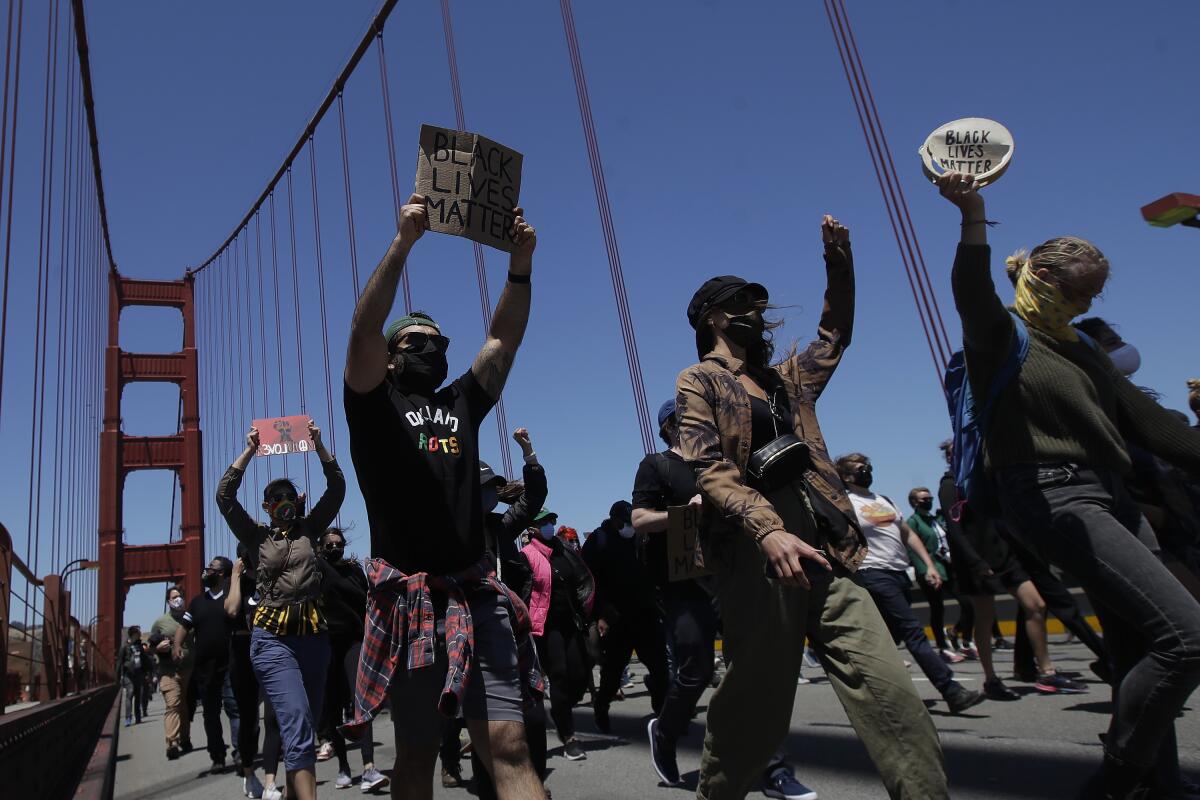Why are Black and Latino people still kept out of the tech industry?

It seemed like tech was turning a corner.
For years, the industry’s giants had resisted calls to disclose workforce diversity data, making it difficult to pinpoint precisely how much whiter and more male Silicon Valley was than the population at large. But Google’s 2014 decision to publish the racial and gender breakdown of its workforce appeared to signal a sea change.
For the record:
9:20 p.m. June 24, 2020An earlier version of this story stated that 12% of 2016 graduates earning degrees in science, technology, engineering and medicine 2016 were Black. That figure is the percentage of all Black graduates earning STEM degrees, according to the National Center for Education Statistics. Of all STEM graduates in 2016, 6.5% were Black. In addition to correcting the error, this story has been updated with more recent data for graduates earning computer and information science degrees, a more relevant statistic.
The numbers revealed an industry dominated by white and Asian men. Of nearly 50,000 employees at Google in 2014, 83% were men, 60% were white, and 30% were Asian. Just 2.9% were Latino, and 1.9% Black. A year later, as other major Silicon Valley companies began releasing their own diversity numbers, Google announced it would dedicate $150 million to increasing diversity at the company.
In the years since, Google has more than doubled its workforce but made minimal progress toward a more representative one. The numbers are similar across the industry.
This lack of diversity — as of May, Google reported that 5.9% of its employees and contractors are Latino and 3.7% are Black — extends up through the ranks of top executives, entrepreneurs who found companies, and venture capitalists who invest in startups.
The industry, which prides itself on agility, has failed to move the needle on workplace diversity. The net result is an entire sector of the economy — the sector that has created the most wealth in California in the last 10 years, minted billionaires, and reshaped the San Francisco Bay Area in its own image — that is functionally barely open to Black and Latino people.
A survey of 67 workers highlighted the issues faced by people of color, women and LGBTQ people in the tech industry.
Tech leaders have often pointed to a “pipeline problem” to explain away the lack of Black hiring and promotion. But in 2016, 8.6% of graduates with a bachelor’s degree in computer and information science were Black and a little over 10% were Latino, according to the National Center for Education Statistics. Even the graduating class of computer science majors at Stanford, Silicon Valley’s elite training ground, is more diverse than the companies just down the road from campus.
Whether you set targets based on the national population or STEM graduates, few tech companies come close, said Freada Kapor Klein, a founding partner at the venture capital firm Kapor Capital who’s been advocating for increasing diversity in tech for decades.
“There are a lot of hard and fast numbers you could use to set the goalposts,” Kapor Klein said. “But [tech companies] aren’t even in the parking lot — they’re so far from the field they need binoculars to see them.”
The problem, in Kapor Klein’s estimation, is not one of education but of access and support. A number of Black tech professionals agree that the industry’s reliance on personal relationships to grant access and opportunity is partly to blame, producing a network effect that militates against Black and Latino inclusion.
The origin of the tech ecosystem — venture capital funds — typifies the problem.
Kanyi Maqubela, managing partner of Kindred Ventures, said that the industry’s reliance on personal relationships perpetuates a system of gate-keeping that is almost designed to keep investors like him out.
Black investors make up less than 1% of venture capitalists. And it’s a small world to begin with. In 2018, just 713 individual investors at large venture funds, defined as having more than $250 million under management, had the power to lead deals, sit on boards, and write checks to invest in companies, according to an Information survey. Of that group, 11 were Latino and seven were Black.
A number of premier firms — such as Sequoia, Benchmark, Greylock, and Kleiner Perkins — have no Black partners at all.
The large pools of money that invest in venture capital funds as limited partners will trust new venture capitalists to handle their money only if more established investors they’ve worked with in the past will vouch for them — and more established Black investors are few and far between.
When a Black VC goes out to try to raise a new fund from those limited partners, Maqubela said, “They’re taking all the demographic patterns they know and applying them purely against you.”
“I was fortunate to have attracted or recruited a number of mentors who decided to coach me and vouch for me, almost all white men,” Maqubela said, “so when I went out to raise a fund I had over a dozen people talking and making calls on my behalf as a way of indicating that I was in the club.”
That barrier makes it difficult for Black VCs to establish strong track records of investing large amounts of money and generating large returns for their LPs on their own. BLCK VC, a group founded in 2018 as a support and organizing network, has the stated mission of increasing the number of Black VCs from 200 to 400 by 2024, in an industry with nearly 4,000 active investors nationwide.
“I’ve spoken to a black VC who could run circles around me intellectually on finance, product, you name it, but didn’t know you needed strong references to go to LPs credibly,” Maqubela said. “It is a testament to the structural nature of how venture capital is broken.”
This system has made for a venture capital landscape that is less diverse than more mainstream financial institutions. Six percent of investment bankers and nearly 9% of financial consultants are Black, compared with less than 1% for venture capital, according to a 2017 Harvard Business School study.
The issues in venture capital persist throughout the industry.
The percentage of Black employees at major tech companies remains low: 2.9% at Salesforce, 3.8% at Facebook, 4.4% at Slack, 4.5% at Microsoft, and 6% at Twitter. Lyft and Uber’s workforces are 9% and 9.3% Black, respectively, but that skews heavily toward their lower-paid operations teams. Apple’s workforce is 9% Black, but that includes retail employees. Amazon, which employs nearly 800,000 people around the world, mostly in its low-wage warehouse and logistics jobs, has a workforce that’s 26.5% Black as a whole, but only 8.3% Black among managers.
The number of Black people in leadership or highly compensated technical roles is lower still. For instance, at Google, only 2.6% of leadership and 2.4% of technical workers are Black. At Facebook, Black people make up only 3.1% of those in leadership roles and 1.5% of those in technical roles.
Fewer than 1% of startup founders who receive venture funding are Black. And with few Black investors sitting on their boards, the percentage of Black top executives at major tech companies is even lower.
The problem is not a lack of qualified candidates, but the companies’ unwillingness to open the door, said Bari Williams, the head of legal at Human Interest, a financial services startup.
Companies are reluctant to broaden the schools they recruit from to include historically Black colleges and universities, said Williams, who advocates for diversity in Silicon Valley. “It always comes down to some semblance of seeing it as lowering the bar,” she said. Williams, who used to work at StubHub and Facebook, said she’s seen candidates get passed over because they attended an HBCU.
Many tech companies also rely heavily on referrals from current employees, a system that is not unusual in business but which can reinforce the network effects. “Who do you typically refer? People that look and act and dress and speak and do the same things that you do,” Williams said.
Once hired, employees have to overcome further hurdles to success. People in senior roles “want to mentor and groom people who look like them or remind them of themselves,” Williams said. “So you don’t have somebody who’s going to advocate for you.”
The result is that even when Black and Latino people do get in the door, they often find themselves looking for the exit before long, and turnover remains high.
“Tech’s approach to diversity the last few years has been like filling the bathtub with the drain open,” said Kapor Klein, who co-wrote a 2017 study on the topic. She said companies need to do the hard work of inspecting everything from hiring and investment practices to who runs the HR department to root out practices that alienate and exclude underrepresented groups. “If they’re biased, fix ‘em,” she said.
Since the national protests over the killing of George Floyd in police custody sparked an examination of structural racism across American society, a number of venture capital funds and tech companies have announced initiatives to readdress the lack of Black and Latino representation.
The Japanese tech giant SoftBank, which has made waves in the tech world with its $100-billion Vision Fund in recent years, announced a $100-million Opportunity Fund in early June to invest exclusively in entrepreneurs of color. The same day, Andreessen Horowitz, a leading venture fund in Silicon Valley with $14 billion under management, announced a similar fund that began with $2.2 million from the firm’s partners but is slated to grow with more contributions.
A number of companies have put out statements of solidarity with the protests, though some have been at odds with the companies’ business and hiring practices to date. Microsoft and Apple have committed to focusing on hiring and retention of Black employees, with Apple pledging $100 million to support the effort. And many companies have committed to supporting racial justice nonprofits or Black-owned businesses, with Google pledging more than $175 million and Facebook and Amazon donating $10 million to racial justice nonprofits. Facebook also announced that it would dedicate $100 million to supporting Black-owned businesses this year, through a mix of grants and free advertising credits on its platform, and commit to give $100 million of business to Black-owned suppliers each year, among other efforts.
Black tech professionals, who have seen waves of commitment come and go, say they are waiting to see whether these pledges result in concrete changes in hiring, mentorship and investment.
Brentt Baltimore, a senior associate at the Los Angeles venture fund Greycroft and a member of BLCK VC, said that he and his peers in the group have been inundated in recent weeks with questions from people across the industry asking how to do better.
Baltimore said that he’s glad more people are talking about the problem, but that what’s really needed is “boots on the ground”: consistent money, time and leadership dedicated to actively bringing more Black tech professionals and investors into the industry.
Without that, he said, “I don’t see much structural change.”








